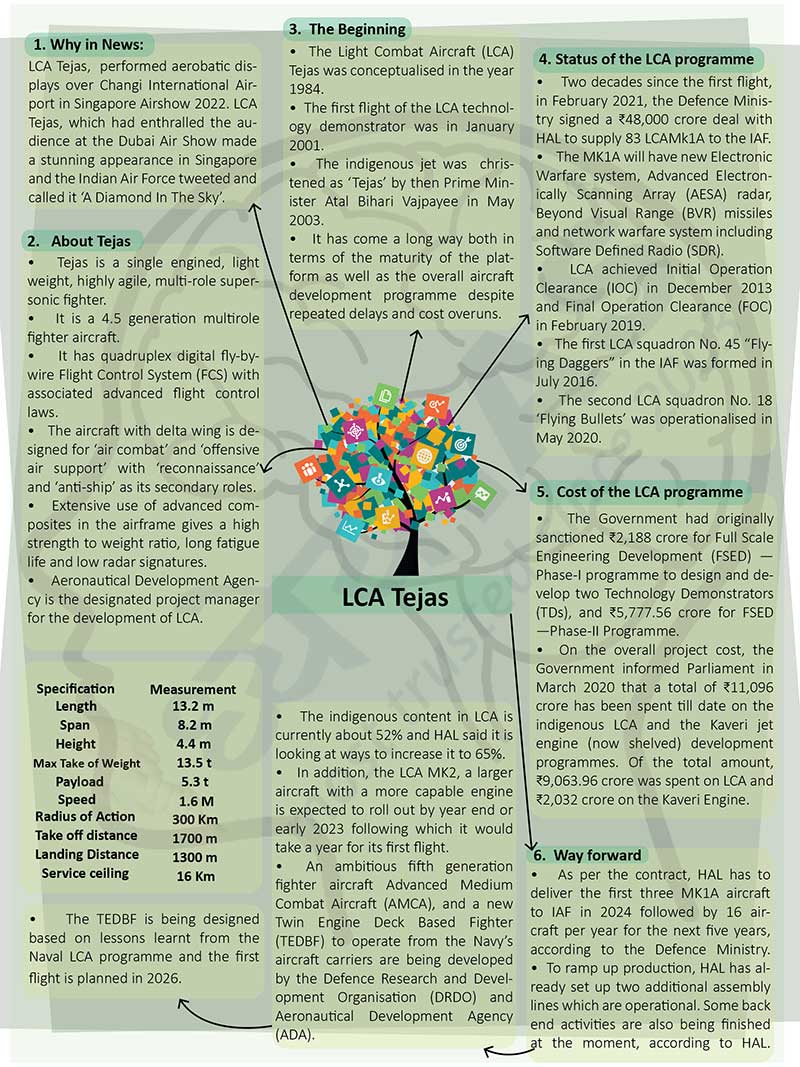Why in News?
- LCA Tejas, performed aerobatic displays over Changi International Airport in Singapore Airshow 2022. LCA Tejas, which had enthralled the audience at the Dubai Air Show made a stunning appearance in Singapore and the Indian Air Force tweeted and called it ‘A Diamond In The Sky’.
About Tejas
- Tejas is a single engined, light weight, highly agile, multi-role supersonic fighter.
- It is a 4.5 generation multirole fighter aircraft.
- It has quadruplex digital fly-bywire Flight Control System (FCS) with associated advanced flight control laws.
- The aircraft with delta wing is designed for ‘air combat’ and ‘offensive air support’ with ‘reconnaissance’ and ‘anti-ship’ as its secondary roles.
- Extensive use of advanced composites in the airframe gives a high strength to weight ratio, long fatigue life and low radar signatures.
- Aeronautical Development Agency is the designated project manager for the development of LCA.

The Beginning
- The Light Combat Aircraft (LCA) Tejas was conceptualised in the year 1984.
- The first flight of the LCA technology demonstrator was in January 2001.
- The indigenous jet was christened as ‘Tejas’ by then Prime Minister Atal Bihari Vajpayee in May 2003.
- It has come a long way both in terms of the maturity of the platform as well as the overall aircraft development programme despite repeated delays and cost overuns.
Status of the LCA programme
- Two decades since the first flight, in February 2021, the Defence Ministry signed a ₹48,000 crore deal with HAL to supply 83 LCAMk1A to the IAF.
- The MK1A will have new Electronic Warfare system, Advanced Electronically Scanning Array (AESA) radar, Beyond Visual Range (BVR) missiles and network warfare system including Software Defined Radio (SDR).
- LCA achieved Initial Operation Clearance (IOC) in December 2013 and Final Operation Clearance (FOC) in February 2019.
- The first LCA squadron No. 45 “Flying Daggers” in the IAF was formed in July 2016.
- The second LCA squadron No. 18 ‘Flying Bullets’ was operationalised in May 2020.
Cost of the LCA programme
- The Government had originally sanctioned ₹2,188 crore for Full Scale Engineering Development (FSED) — Phase-I programme to design and develop two Technology Demonstrators (TDs), and ₹5,777.56 crore for FSED —Phase-II Programme.
- On the overall project cost, the Government informed Parliament in March 2020 that a total of ₹11,096 crore has been spent till date on the indigenous LCA and the Kaveri jet engine (now shelved) development programmes. Of the total amount, ₹9,063.96 crore was spent on LCA and ₹2,032 crore on the Kaveri Engine.
Way forward
- As per the contract, HAL has to deliver the first three MK1A aircraft to IAF in 2024 followed by 16 aircraft per year for the next five years, according to the Defence Ministry.
- To ramp up production, HAL has already set up two additional assembly lines which are operational. Some back end activities are also being finished at the moment, according to HAL.
- The indigenous content in LCA is currently about 52% and HAL said it is looking at ways to increase it to 65%.
- In addition, the LCA MK2, a larger aircraft with a more capable engine is expected to roll out by year end or early 2023 following which it would take a year for its first flight.
- An ambitious fifth generation fighter aircraft Advanced Medium Combat Aircraft (AMCA), and a new Twin Engine Deck Based Fighter (TEDBF) to operate from the Navy’s aircraft carriers are being developed by the Defence Research and Development Organisation (DRDO) and Aeronautical Development Agency (ADA).
- The TEDBF is being designed based on lessons learnt from the Naval LCA programme and the first flight is planned in 2026.









